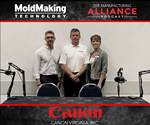3 Is the Magic Number
Canon Virginia kicks off this free webinar telling attendees that they will not be sharing something they don’t already know, but will share a few best practices for getting things right the first time—three steps to improve medical tooling and validation times.

An initial real-time poll reveals that the greatest hurdle to getting a product to launch is equal across time-to-market, quality and cost reduction … until time-to-market took the lead in the end. With that in mind, Canon Virginia Inc. reviewed three steps to improve these factors:
-
1. Design for manufacturing (DFM)
- Design for injection mold tooling (DFIM) is really design for moldability.
- There are 3 ways DFIM can help reduce costs and time-to-market:
- To the moldmaker: improve ease of machining; simplify the mold and win over the customer
- To the molder: maintain robust process windows, improve repeatability and quality; speed up validation
- To the manufacturer: ensure incoming parts meet specs, reduce assembly processes and enhance product quality
-
2. Instrumentation and scientific injection molding (SIM)
- Instrumentation is the process of installing a series of sensors within the mold to provide key data points in the injection molding process.
- SIM is a disciplined approach to building robust molding processes for repeatability and high-quality outcomes.
-
3. Part validation
- A second poll reveals that the two greatest benefits of part validation according to attendees are:
Standardized process
Consistent quality
Repeatability
Clear documentation
- Part validation verifies that the part quality is repeatable for mass production, ensures part quality meets customer specs and enables the product to move to market with a documented paper trail.
Some questions that were discussed during the Q&A include:
- How do you balance gross mold adjustments using an unvalidated process during initial mold sampling vs fine-tune adjustments after the process is validated?
- How far should you go in adjusting the mold before SIM begins?
- What type of support does Canon provide at the start of production?
- What if I’m not getting the same results?
- What guidelines do you use to perform DFM?
- Is DFM/DFIM always done in-house?
- Is this a service Canon provides?
- What are the most common problems that you run into when validating manufacturing processes?
- How do I know if the process has been validated correctly?

- What are the benefits of process validation over inspection of the final product?
- How do I decide which one is best?
- Do you go through a checklist during part and tooling DFM review?
- Do you prefer direct or indirect (behind the pin) sensor instrumentation?
- Sometimes changing the machine causes parts being out of spec, poor surface finish, flash, etc. How does Canon address this issue?
- How do you determine shrink rate for the new materials?
- Do you have conformal cooling capability for complex tooling?
- Do you need prototyping to determine shrink rate for new material?
To view this 45-minute webinar, click here
Related Content
-
Mold Builder Uses Counter-Intuitive Approach for Mold Challenges
Matrix Tool Inc. answers customers’ hard questions with creative solutions for cavity spacing, tool sizing, runner layout and melt delivery that reveal the benefits of running in a smaller press size at lower cavitation but higher yield.
-
Plastic Prototypes Using Silicone Rubber Molds
How-to, step-by-step instructions that take you from making the master pattern to making the mold and casting the plastic parts.
-
MMT Chats: Twice the Efficiency with Canon Virginia Inc.'s Shuttle Mold System. Also, What Does Customer Outreach Look Like During a Pandemic?
Many people know Canon for their state-of-the-art cameras and equipment. Little do they know, they also have hands in the moldmaking industry. In this MMT Chat, MoldMaking Technology Editorial Director Christina Fuges had the chance to discuss Canon Virginia Inc.'s Shuttle Mold System with Director of Business Development Wayne Daniel. This episode is brought to you by ISCAR with New Ideas for Machining Intelligently.















.png;maxWidth=300;quality=90)
